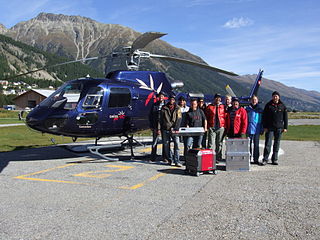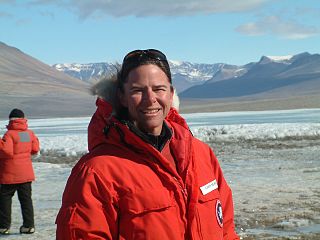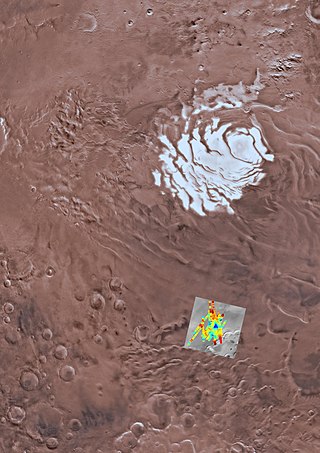
Lake Vostok is the largest of Antarctica's 675 known subglacial lakes. Lake Vostok is located at the southern Pole of Cold, beneath Russia's Vostok Station under the surface of the central East Antarctic Ice Sheet, which is at 3,488 m (11,444 ft) above mean sea level. The surface of this fresh water lake is approximately 4,000 m (13,100 ft) under the surface of the ice, which places it at approximately 500 m (1,600 ft) below sea level.

The McMurdo Dry Valleys are a row of largely snow-free valleys in Antarctica, located within Victoria Land west of McMurdo Sound. The Dry Valleys experience extremely low humidity and surrounding mountains prevent the flow of ice from nearby glaciers. The rocks here are granites and gneisses, and glacial tills dot this bedrock landscape, with loose gravel covering the ground. It is one of the driest places on Earth and is sometimes claimed to have not seen rain in nearly two million years, though this is highly unlikely and several anecdotal accounts of rainfall within the Dry Valleys exist.

Psychrophiles or cryophiles are extremophilic organisms that are capable of growth and reproduction in low temperatures, ranging from −20 °C (−4 °F) to 20 °C (68 °F). They are found in places that are permanently cold, such as the polar regions and the deep sea. They can be contrasted with thermophiles, which are organisms that thrive at unusually high temperatures, and mesophiles at intermediate temperatures. Psychrophile is Greek for 'cold-loving', from Ancient Greek ψυχρός (psukhrós) 'cold, frozen'.

A subglacial lake is a lake that is found under a glacier, typically beneath an ice cap or ice sheet. Subglacial lakes form at the boundary between ice and the underlying bedrock, where gravitational pressure decreases the pressure melting point of ice. Over time, the overlying ice gradually melts at a rate of a few millimeters per year. Meltwater flows from regions of high to low hydraulic pressure under the ice and pools, creating a body of liquid water that can be isolated from the external environment for millions of years.

Blood Falls is an outflow of an iron oxide–tainted plume of saltwater, flowing from the tongue of Taylor Glacier onto the ice-covered surface of West Lake Bonney in the Taylor Valley of the McMurdo Dry Valleys in Victoria Land, East Antarctica.

IceMole is an autonomous ice research probe, incorporating a new type of ice-melting tip for the exploration of polar regions, glaciers, ice sheets, and extraterrestrial regions, developed by a team from the FH Aachen, a Fachhochschule in Aachen, Germany. The advantage over previous probes is that the IceMole can change its direction and can be recovered after being used. A driving ice screw allows the probe to drill through soil layers and other contaminations in the ice.
There are hundreds of antarctic lakes in Antarctica. In 2018 researchers at the Alfred Wegener Institute for Polar and Marine Research published a study they claimed cast doubt on the earlier estimate that there were almost 400 subglacial antarctic lakes. Antarctica also has some relatively small regions that are clear of ice and snow, and there are some surface lakes in these regions. They called for on the ground seismic studies, or drilling, to determine a more reliable number.

Dr. Mary A. Voytek is the director of the National Aeronautics and Space Administration (NASA) Astrobiology Program at NASA Headquarters in Washington, D.C. In 2015, Voytek formed Nexus for Exoplanet System Science (NExSS), a systems science initiative by NASA, to search for life on exoplanets. Voytek came to NASA from the U.S. Geological Survey in Reston, VA, where she headed the USGS Microbiology and Molecular Ecology Laboratory from 1998 to 2009.

Lake Whillans is a subglacial lake in Antarctica. The lake is located under the Whillans Ice Stream at the southeastern edge of the Ross Ice Shelf in the west of the continent. The lake surface is 800 m (2,600 ft) beneath the surface of the ice and the lake covers an estimated area of 60 km2 (20 sq mi). Lake depths measured thus far have been around 2 metres. Its temperature is −0.49 °C, below 0 °C because of the high pressure.
Geopsychrobacter electrodiphilus is a species of bacteria, the type species of its genus. It is a psychrotolerant member of its family, capable of attaching to the anodes of sediment fuel cells and harvesting electricity by oxidation of organic compounds to carbon dioxide and transferring the electrons to the anode.
Enceladus Explorer (EnEx) is a planned interplanetary orbiter and lander mission equipped with a subsurface maneuverable ice melting probe suitable to assess the existence of life on Saturn's moon Enceladus.

Cristina Takacs-Vesbach is an American microbial ecologist conducting research on the productivity, diversity, and function of microbial communities living at the two extremes of temperature found on Earth-Antarctica's McMurdo Dry Valleys and Yellowstone National Park's thermal springs.

Trista Vick-Majors is an American Assistant Professor in Biological Sciences at Michigan Tech. She is an Antarctic biogeochemist and microbial ecologist, best known for her work showing that microorganisms are present under the Antarctic ice sheet.

Alison Murray is an American microbial ecologist and Antarctic researcher, best known for studying the diversity, ecology and biogeography of Antarctic marine plankton dynamics of the plankton over the annual cycle; and her work demonstrating the existence of microbial life within an ice-sealed Antarctic lake. She studies how microorganisms persist and function in extremely cold and harsh environments, including those that lack oxygen and biological sources of energy.
Mars habitability analogue environments on Earth are environments that share potentially relevant astrobiological conditions with Mars. These include sites that are analogues of potential subsurface habitats, and deep subsurface habitats.
Martin J. Siegert is a British glaciologist, and Deputy Vice Chancellor (Cornwall) at the University of Exeter. He co-Chairs the Diversity in Polar Science Initiative, and has spoken about socio-economic inclusion in Polar Science and indeed broader society.
Ann Pearson is the PVK Professor of Arts and Sciences and Murray and Martha Ross Professor of Environmental Sciences at Harvard University and former chair of the Department of Earth and Planetary Sciences. Her research in the area of organic geochemistry is focused on applications of analytical chemistry, isotope geochemistry, and microbiology to biogeochemistry and Earth history.

Sea Ice Microbial Communities (SIMCO) refer to groups of microorganisms living within and at the interfaces of sea ice at the poles. The ice matrix they inhabit has strong vertical gradients of salinity, light, temperature and nutrients. Sea ice chemistry is most influenced by the salinity of the brine which affects the pH and the concentration of dissolved nutrients and gases. The brine formed during the melting sea ice creates pores and channels in the sea ice in which these microbes can live. As a result of these gradients and dynamic conditions, a higher abundance of microbes are found in the lower layer of the ice, although some are found in the middle and upper layers. Despite this extreme variability in environmental conditions, the taxonomical community composition tends to remain consistent throughout the year, until the ice melts.
Mercer Subglacial Lake is a subglacial lake in Antarctica covered by a sheet of ice 1,067 m (3,501 ft) thick; the water below is hydraulically active, with water replacement times on the order of a decade from the Ross Sea. Studies suggest that Mercer Subglacial Lake as well as other subglacial lakes appear to be linked, with drainage events in one reservoir causing filling and follow-on drainage in adjacent lakes.

Salty subglacial lakes are controversially inferred from radar measurements to exist below the South Polar Layered Deposits (SPLD) in Ultimi Scopuli of Mars' southern ice cap. The idea of subglacial lakes due to basal melting at the polar ice caps on Mars was first hypothesized in the 1980s. For liquid water to persist below the SPLD, researchers propose that perchlorate is dissolved in the water, which lowers the freezing temperature, but other explanations such as saline ice or hydrous minerals have been offered. Challenges for explaining sufficiently warm conditions for liquid water to exist below the southern ice cap include low amounts of geothermal heating from the subsurface and overlying pressure from the ice. As a result, it is disputed whether radar detections of bright reflectors were instead caused by other materials such as saline ice or deposits of minerals such as clays. While lakes with salt concentrations 20 times that of the ocean pose challenges for life, potential subglacial lakes on Mars are of high interest for astrobiology because microbial ecosystems have been found in deep subglacial lakes on Earth, such as in Lake Whillans in Antarctica below 800 m of ice.














